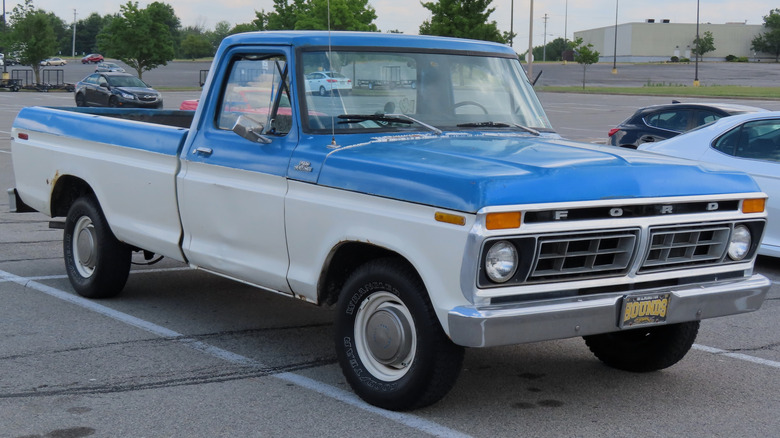When Did The Ford F-150 Replace The F-100?
For many years, the Ford F-Series has been the best-selling line of vehicles in the United States, and as of this writing, it is poised to take the top spot yet again in 2025. The crown jewel of this line of pickup trucks is without question the Ford F-150, the full-size pickup that is still getting high marks here at SlashGear decades into its existence. The popularity of the F-150 has turned it into the symbol of the American automotive landscape and is what every other automaker is trying to overtake. Because of its ubiquity, it feels like the F-150 has always existed, but of course, that isn't the case. In the grand scheme of the Ford F-Series, the F-150 is actually a relatively recent vehicle.
At the very start of the F-Series for the 1948 model year, the half-ton pickup truck was called the F-1, but in the second generation for the 1953 model year, this pickup was renamed the Ford F-100. For a couple of decades, this would be the standard bearer of Ford pickup trucks. The F-150 would not be introduced until the 1975 model year, but at that time, it was not an F-100 replacement. The two trucks were being sold alongside each other. The difference between the two basically boiled down to their respective weights. A 1975 F-100 had a GVWR (Gross Vehicle Weight Rating) of 5,500 pounds, whereas the F-150 raised that to 6,050 pounds. The two trucks would continue to be sold simultaneously until 1983, which is when Ford finally shuttered the F-100 model for good and made the F-150 the base model of the F-Series.
Why was the Ford F-150 created
The main difference between the Ford F-100 and F-150 models was their respective GVWR, and consequently, the F-150 was able to carry a bigger payload than the F-100. For some customers, this was certainly a big reason to switch over from the lighter truck, as hauling materials is one reason why a lot of people purchase pickup trucks in the first place. Being able to haul more in a truck that actually isn't that much bigger is a nice compromise. However, another reason Ford decided to gravitate towards the F-150 and leave the F-100 behind is a bit more underhanded.
The 1970s were a tumultuous time for the automobile industry, as two major things affected automakers. There was an oil embargo, which resulted in the creation of several terrible Ford models, and we saw the formation of the Environmental Protection Agency, which aimed to reduce harmful automobile emissions. The EPA instituted many emissions restrictions in the mid-1970s, and the F-100 was one vehicle affected by it. Ford devised a plan to essentially create a new F-100 but be able to classify it as a heavy-duty truck instead of a light one. That's where the F-150 comes into play. You had all of the benefits of the F-100, but the added weight placed the truck in a different category, to which these new restrictions didn't apply. It was a sneaky gambit, but it paid off. Eventually, Ford saw that it just needed to put its weight behind the F-150, and over 40 years later, that scheme created one of the most popular vehicles of all time.

